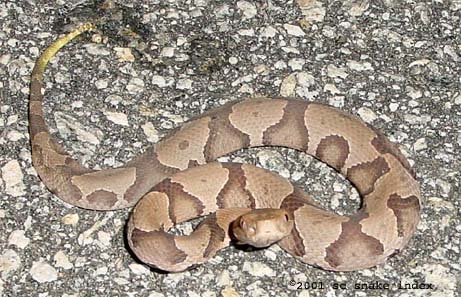

Copperhead Snake
(Agkistrodon contortrix)
The copperhead snake is found within Class Reptilia, Subclass Lepidosauria, and Order Squamata. They are generally ectothermous or poikilothermous (cold blooded) (Van de Graff and Crawley 1998). It is the most common venomous snake found in the Eastern United States, and is a member of the pit viper. The copperhead is usually colorful and distinctly patterned, with the name being derived from the copper coloring of the head. Adults are usually 24 to 36 inches in length but can be over 42 inches. Common habitats are near streams. Copperheads give birth to live young (ovoviviparous). Their diet includes small rodents, lizards, birds, snakes, amphibians, and insects (SC Snake Index 2001). Snakes are very similar to tetrapods with the exception of limbs, which were lost do to selective evolutionary processes (Kardong 2002).
References:
Kardong, Kenneth V. Ph.D. (2002) Vertebrates- Comparative Anatomy, Function, Evolution. 3rd Ed. McGraw Hill: New York.
SC Snake Index. (2001) www.snakesandfrogs.com/scra/snakes/copperh.htm
Van de Graaff, Kent M. and John L. Crawley. (1998) A Photographic Atlas for the Zoology Laboratory. 3rd Ed. Morton Publishing Company: Colorado.
Zug, George R., Laurie J. Vitt, Janalee P. Caldwell. (2001) Herpetology – An Introductory Biology of Amphibians and Reptiles. 2nd Ed. Academic Press: California.
Created by Sara Viernum and Kim Breeden